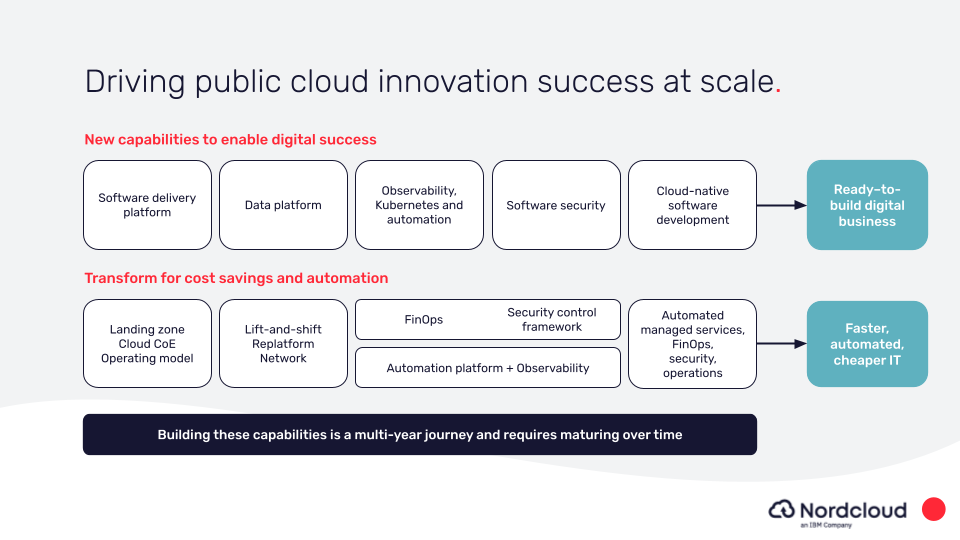
2 essential cloud success pillars for manufacturers
The manufacturing industry is under pressure to transform. Growing competition, rising costs, tight supply chains and growing customer demands are putting pressure on companies to act fast. You need flexible, scalable platforms to meet these challenges, opening up new prospects for IT to make a real business impact. In the past, IT’s responsibility was mainly limited to providing necessary infrastructure. Now, IT also must increasingly focus on enabling new business ideas and technical innovation.
Public cloud has become the de facto engine to help IT deliver this innovation
Cloud usage and cloud-based innovations top the list of priorities for many of our manufacturing, industrial and automotive customers – who see public cloud as essential to helping them get ahead of the game.
The rationale is simple: homegrown IT solutions and infrastructure don’t – and can’t – help any company achieve competitive advantage fast enough. They’re inflexible, expensive and time-consuming to build, which means budgets and resources get consumed without really adding value to an immediate business challenge.
From our perspective, AWS, Microsoft Azure and GCP surpassed the average on-premises server/container platforms in aggregate capability many years ago. They offer everything needed to digitalise at scale, out of the box. After all, time is a key aspect of competitive advantage – and public cloud solves it!
The 2 pillars of cloud success at scale
To get started (and obviously many customers we work with already have started), there are 2 pillars to consider for succeeding with cloud innovation at scale:
- Horizontal: Infrastructure and development platforms
- Vertical: Digital solutions and services

Cloud is more than just a data centre. We advise manufacturers to use public cloud for digital solutions solving real business problems and to supercharge their software development and developer experience. However, in order to make this scale, the IT governance and automation foundations of that horizontal pillar should be done right.
Horizontal pillar: Tackle IT governance and platform challenges first
Our cloud security community is helping us achieve that. It’s a forum for knowledge sharing, empowerment, skills development and careers advancement.
Having worked with industrial companies from the north of Finland to the south of Germany, we’ve gained a huge experience in how to help organisations fulfill the promise of cloud at scale in the enterprise.
We’ve learned a key lesson: you have to solve basic horizontal IT challenges in cloud before you can innovate and build digital solutions in a production-ready state.
Over the years we’ve built internal cloud competency centres and leveraged our partners in AWS, Azure and GCP to help customers operating huge cloud estates in a unified, secure and cost-efficient way. We advise clients to balance control and speed at all times when building these foundations and platforms. You must make sure you’re not compromising the value cloud brings to the business or the developers using it.
This means avoiding 2 classic cloud adoption pitfalls:
- Pushing for cloud-based innovation without fixing the basics: Thereby creating a mess others have to untangle well past the point where digital services go into the production stage
- Restricting cloud usage so it becomes impossible to innovate with it: Meaning you end up back where you started – with an inaccessible managed hosting farm that doesn’t let you harness hyperscaler tech
You need to strike a balance between these extremes – and we can help. Our aim is to enable cloud value at the absolute highest possible level without compromising the security, compliance or control mechanisms that safeguard your core business and your customers. The very idea of cloud is about allowing engineers to experiment with a vast tooling landscape, with full access to everything hyperscalers have to offer. So to get devs to start making the most of cloud for your business, you need to build platforms, not prisons.
A great example of this is how we’ve helped BMW to build a Public Cloud Platform that enables multi-cloud governance and operations at scale. The platform provides standardised, automated and pre-developed cloud infrastructure so internal teams can use self-service/APIs and develop rapidly while aligning with established rules. For example, users can automatically create new accounts and subscriptions directly in the platform without having to raise a ticket or wait for an internal, manual process. Integrated security features ensure end-to-end monitoring and enforcement of security and regulatory rules.
This gives BMW the ideal balance between speed and control.
Vertical pillar: Innovate and supercharge your teams with cloud
Cloud technology allows you to scale innovation and speed up time to market. Developer experience and productivity reach new levels when they use hyperscalers’ rich service stacks. But playing with cool stuff is only one part of the story. It’s also important to foster the right type of culture and build the right processes in the horizontal pillar to ensure innovation can happen. As we said: there must be a balance between speed and control.
Our view is that in order to build sustainably on cloud, developers need production-ready frameworks and tools, together with support teams to take over the application (whether it’s a central function of the IT organisation, a third party or internal staff in their product group).
The vertical pillar is made up of 3 elements:
- Digital products and services
- Data platforms
- Developer experience and culture
Digital products and services: The primary outcome of using cloud for the business is the creation of products and services that either serve the end customer or optimise production and supply chains. Whatever the business domain, we see the same basic patterns of cloud-native and globally scaled building blocks used to create these solutions. Manufacturing companies thrive when their solutions are available to all clients in the same manner – whether it’s remote monitoring, shop-floor level optimisation and prediction, or aftersales customer interfaces and platforms.
Data platforms: Data platforms (often referred to as data lakes) underpin most of the digital products and services we’ve built with our manufacturing customers. These offer a secure and controlled environment where engineers and data scientists can access almost any kind of company data – from production to field sensors. Building a reliable and scalable data platform is essential for building digital products that deliver business value. The individual feature teams shouldn’t be burdened with transforming or governing data.
Developer experience and culture: Those first 2 vertical pillar elements are harder to build when engineers don’t benefit from a great developer experience and culture. Developer experience can be supercharged with cloud. However, as part of the cloud journey, you also need to check your culture and processes associated with developing digital solutions. Teams need autonomy, agility and trust to do the right thing. For example, when working with bearing and seal manufacturer SKF to scale out a cloud-empowered agile innovation culture, we used both coaching and technical tooling. Nordcloud experts were embedded in SKF’s feature teams to make sure every squad could walk the talk.
Checking your cloud balance
Our #1 tip for manufacturing, automotive and industrial companies is to fast-track a cloud strategy review to ensure you’re striking the right balance with the 2 pillars. Otherwise, you’re destined to hit either wall of innovation-preventing governance or technical debt and security leaks.
Success with cloud isn’t just about using hyperscaler tools to innovate – it’s about using the right hyperscaler tools at the right time in a secure and sustainable way. Don’t jump on bandwagons or superimpose tech trends on to legacy solutions and ways of working.
From migrating infrastructure to digitalising manufacturing operations and developing new data-driven customer tools – we’ve helped so many manufacturers get value from cloud fast.
We’re talking a 30% reduction in deployment costs (Porsche), 2x the mileage from the R&D budget (Kempii) and a new sensor-driven customer app in 8 weeks (Konecranes). The list goes on.
When you take an approach that involves collaboration between your teams, your partner and your hyperscaler – you position the business to thrive in a competitive market. Get in touch to see how we can make that collaboration happen.
Get in Touch.
Let’s discuss how we can help with your cloud journey. Our experts are standing by to talk about your migration, modernisation, development and skills challenges.



